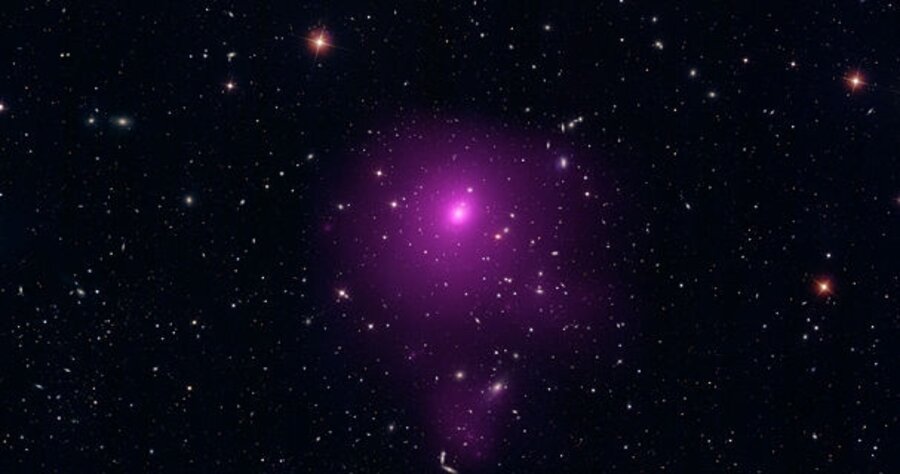New light on dark energy
Loading...
Dark energy is coming in from the cold.
Astronomers announced today that they have uncovered dark energy's influence on the evolution of galaxy clusters -- among the largest collapsed structures in the universe. In effect, dark energy -- an unexpected, repulsive force astronomers discovered in the late 1990s -- is putting a cap on how large these structures can get.
"This may well be called arrested development of the universe," says Alexey Vikhlinin, an astrophysicist at the Harvard-Smithsonian Center for Astrophysics in Cambridge, Mass., who led the research team reporting the results. "We're observing the unambiguous signature of the effects of dark energy on the growth of structure" in the universe.
Dark energy is causing the very fabric of space-time to expand at an accelerating rate, researchers say. Over the very long haul, the Chandra results imply that the universe will not end in a "big rip," with everything violently torn apart.
Instead, Dr. Vikhlinin says, any objects too loosely bound by gravity to overcome the repulsive force of dark energy will gradually vanish into the distance.
From the vantage point of the Milky Way -- or "Milkomeda" after its merger with the Andromeda Galaxy in about 3 billion years -- it will be lights out on the Vigro Cluster, a gathering of at least 1,300 galaxies in a gravitationally corralled herd some 60 million light-years from Earth.
The results, based on observations taken using NASA's Chandra X-Ray Observatory, are helping to shrink the list of possible answers to the question: What's responsible for dark energy?
Two candidates remain standing, explains David Spergel, a theorist in astrophysics at Princeton University in Princeton, N.J.
What's doing it?
One involves an ultralight among subatomic particles. Dubbed quintessence, the particle is associated with the kind of force field that interacts only very weakly with matter and is unstable. Some researchers suggest that this energy drove the rapid expansion that the universe underwent during its inflationary period, which is thought to have taken place during the first trillionth of a second after the big bang. Energy from this hypothesized quintessence field is one candidate for dark energy.
The other is something called vacuum energy -- a form of energy that stems from calculations in quantum physics. This energy would be present even if the universe held no matter. And it remains constant as the universe evolves, Dr. Spergel says.
In effect, it's Albert Einstein's cosmological constant -- a fudge factor he included in his calculations of general relativity's effect on the universe. His calculations implied that gravity from all the matter in the universe would force the cosmos to contract. But he was partial to a static universe. So he included the constant to push things apart just enough to offset gravity's pull. He tossed it out as his "greatest blunder" after observations showed that, yes, Albert, the universe is expanding.
"A quantum fluctuation in a vacuum has some tiny energy associated with it," Spergel explains. And energy has mass. "One way to think about this is that even nothing weighs something. And because in our universe we've got a lot of nothing, it has a major effect on our evolution."
At this point, he says, the vacuum-energy approach describes dark energy quite well. In short: Einstein leads by a length.
Chandra strikes again
Vikhlinin's international team achieved its results by using Chandra to observe some 86 galaxy clusters, which typically ranging from 30 million to 100 million light-years across. The clusters are surrounded by enormous halos of hot gas that generate copious amounts of x-ray radiation. The halos represent the bulk of the cluster's matter. This allows astronomers to detect and study clusters at far greater distances than would be possible using visible light.
Roughly half the clusters were at a distance of some 5.5 billion light-years; the rest were virtually next door, at a distance of some 670 million light-years. The team also used data from the Wilkinson Microwave Anisotropy Probe, a satellite measuring in exquisite detail slight changes in the density of matter imprinted on the cosmic microwave background -- the afterglow from the big bang some 13.7 billion years ago.
Using the microwave density imprints as a starting point, the team used the two sets of clusters to track the effects of dark energy with time. The results showing when dark energy overcame gravity as the universe's driving force squares nicely with those from studies based on supernovas, which serendipitously led to the discovery of dark matter in the late 1990s.
A special class of these exploding stars, which outshine their host galaxies, serve as standard candles for measuring distances, which translates into time; their spectra yield clues as to how fast the universe is expanding at that distance.
Cluster growth "was fast up until 5.5 billion years ago, while it really slowed down afterwards," Vikhlinin says. "That coincides with the epoch in which the universe entered the accelerated-expansion phase revealed by the supernova data."
The results are scheduled for publication Feb. 10, 2009 in the Astrophysical Journal.





